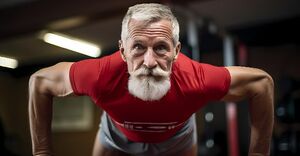
Maximizing Calorie Burn: Combining Aerobic and Anaerobic Workouts
Are you looking to maximize your calorie burn and improve your overall fitness?
We will explore the benefits of combining aerobic and anaerobic workouts.
From increasing calorie burn and boosting metabolism to improving overall fitness, we will discuss how you can create a balanced workout routine that incorporates both types of exercises.
We will also provide examples of aerobic and anaerobic workouts, as well as tips for maximizing calorie burn during your workouts.
Let’s get started!
What Are Aerobic and Anaerobic Workouts?
Aerobic and anaerobic workouts are two essential components of a well-rounded exercise routine.
Incorporating both types of workouts into your fitness regimen can lead to a myriad of benefits. Aerobic exercises, such as running, swimming, or cycling, are fantastic for improving cardiovascular health and increasing overall endurance levels.
On the other hand, anaerobic exercises like weightlifting, sprinting, or high-intensity interval training help build strength and power. By combining these two types of workouts, you can enhance not only your physical fitness but also your mental well-being. It’s important to strike a balance between the two to achieve optimal results in your fitness journey.
What Are the Benefits of Combining Aerobic and Anaerobic Workouts?
Combining aerobic and anaerobic workouts offers a comprehensive approach to fitness that maximizes calorie burn, enhances endurance, and promotes muscle building. This combination is particularly effective for individuals looking to achieve weight loss and improve their overall fitness levels.
Aerobic exercises like running, swimming, or cycling help improve cardiovascular health and increase oxygen flow throughout the body, which aids in burning calories and boosting metabolism.
On the other hand, anaerobic exercises such as weightlifting or high-intensity interval training are crucial for building lean muscle mass, increasing strength, and sculpting the body.
By incorporating both types of workouts into a fitness routine, individuals can experience a well-rounded approach that not only helps in shedding excess fat but also in toning and strengthening muscles for a balanced and healthier physique.
Increases Calorie Burn
One of the key advantages of combining aerobic and anaerobic workouts is the significant increase in calorie burn achieved through high-intensity interval training (HIIT) and cardiovascular exercises. This dual approach challenges the body’s energy systems, leading to a greater caloric expenditure.
As the body engages in HIIT and cardio exercises, it not only burns calories during the workout but also sets in motion post-exercise processes that continue to torch calories at an elevated rate. The intensity of HIIT boosts the afterburn effect, known as excess post-exercise oxygen consumption (EPOC), where the body works harder to restore oxygen levels and repair muscles, resulting in increased energy expenditure. The combination of aerobic and anaerobic activities maximizes the overall metabolic rate, thus optimizing the utilization of energy stores for sustained fat loss.
Boosts Metabolism
The combination of aerobic and anaerobic workouts not only boosts metabolism during the exercise session but also enhances post-exercise energy expenditure, promoting fat loss and improving body composition over time. This metabolic enhancement is crucial for achieving long-term fitness goals.
By engaging in a mix of aerobic activities like running, cycling, or swimming, along with anaerobic exercises such as weightlifting or high-intensity interval training (HIIT), individuals can optimize their metabolic rates for efficient calorie burning. Aerobic exercises stimulate the cardiovascular system, while anaerobic activities help build lean muscle mass, both contributing to an increase in resting metabolic rate. This synergy between the two types of workouts leads to a sustained elevation in metabolism, creating a favorable environment for fat loss and better overall body composition.
Improves Overall Fitness
By combining aerobic and anaerobic workouts, individuals can achieve a balanced approach to fitness that targets muscle building, enhances endurance, and promotes overall physical activity. This holistic approach is instrumental in reaching diverse fitness goals and optimizing performance.
Aerobic exercises, such as running or cycling, help improve cardiovascular health and burn calories efficiently. On the other hand, anaerobic workouts like weightlifting or HIIT sessions focus on building muscle mass and increasing strength.
When these two forms of exercise are combined, they create a well-rounded routine that not only boosts physical endurance but also enhances overall flexibility and agility. The synergy between aerobic and anaerobic activities not only improves physical appearance but also contributes to mental well-being by reducing stress and boosting confidence.
How to Create a Balanced Workout Routine?
Creating a balanced workout routine involves several key steps, starting with defining clear fitness goals, selecting appropriate exercises that cater to aerobic and anaerobic needs, and scheduling workouts strategically to maintain consistency and progress.
It’s essential to set specific, achievable goals that align with your fitness aspirations, whether it’s weight loss, muscle gain, improved endurance, or overall fitness enhancement.
Once your goals are established, consider the intensity levels of your exercises – incorporating a mix of cardiovascular activities for aerobic fitness and strength training for anaerobic capacity.
A well-rounded routine should include flexibility and core-strengthening exercises to enhance overall functional fitness and prevent injuries.
It’s important to develop a holistic fitness strategy that considers not just the exercises but also factors like nutrition, rest, and recovery for long-term success.
Determine Your Goals
Before embarking on a balanced workout routine, it is crucial to identify and prioritize your fitness goals. Whether aiming for weight loss, muscle building, or overall fitness improvement, clearly defining objectives sets the foundation for an efficient and balanced training plan.
Once you have established your fitness goals, the next step is to align your workout routines with these desired outcomes. Tailoring your exercises and training sessions to target specific areas that contribute to your goals can greatly enhance the effectiveness and efficiency of your workouts. For instance, if your goal is to lose weight, incorporating a mix of cardio and strength training exercises can be beneficial. Finding this alignment between your goals and your workout routines is key to seeing progress and maintaining motivation in your fitness journey.
Choose the Right Exercises
Selecting the right mix of exercises that incorporate both aerobic and anaerobic elements is key to ensuring workout variation, preventing plateaus, and continuously challenging the body for improved fitness outcomes. Variety in exercises promotes continuous improvement.
Changing up your workout routine not only prevents boredom but also targets different muscle groups and energy systems, leading to more comprehensive fitness enhancements.
For instance, including compound movements like squats and deadlifts alongside isolation exercises such as bicep curls and tricep extensions can cater to various fitness goals and levels.
Cross-training with activities like swimming, cycling, or yoga can further complement your routine, offering a holistic approach to overall health and well-being.
Schedule Your Workouts
Establishing a consistent workout schedule that balances aerobic and anaerobic sessions is vital for maintaining fitness performance and achieving long-term results. Strategic scheduling ensures adequate recovery, progression, and adaptation to training stimuli.
By incorporating a mix of cardiovascular exercises like running, cycling, or swimming alongside strength training activities such as weightlifting or resistance band exercises, individuals can target different muscle groups and energy systems effectively. Alternating between these types of workouts not only enhances overall fitness but also prevents overtraining and reduces the risk of injury.
Scheduling rest days or light active recovery sessions is crucial to allow the body to recuperate and repair itself, promoting sustainable fitness improvements.
What Are Some Examples of Aerobic and Anaerobic Workouts?
Aerobic workouts such as running, cycling, and swimming focus on enhancing cardiovascular endurance, while anaerobic workouts like weightlifting and high-intensity interval training (HIIT) prioritize strength building and explosive power. Integrating both types of exercises offers a comprehensive fitness approach.
Aerobic exercises, like running and cycling, involve sustained efforts that help improve heart health, lung capacity, and overall endurance. On the other hand, anaerobic exercises, such as weightlifting and HIIT, focus on short bursts of intense activity that build muscle strength and power.
By combining these two types of workouts in a balanced routine, individuals can experience the benefits of improved cardiovascular fitness, increased muscle strength, enhanced endurance, and better overall body composition. This integration also aids in boosting metabolism, burning more calories, and enhancing overall physical performance.
Aerobic Workouts: Running, Cycling, Swimming
Aerobic workouts such as running, cycling, and swimming are foundational activities that enhance aerobic capacity, improve cardiovascular health, and promote oxygen consumption efficiency. These exercises play a crucial role in elevating overall fitness levels and supporting endurance development.
Engaging in regular aerobic exercises can lead to numerous physiological benefits. For instance, running helps strengthen the heart muscles and improve circulation, while cycling aids in increasing lung capacity and overall stamina. Swimming, on the other hand, is a full-body workout that not only boosts cardiovascular fitness but also enhances muscle tone and flexibility. The combination of these activities not only enhances one’s physical health but also influences mental well-being by reducing stress and improving mood through the release of endorphins.
Anaerobic Workouts: Weightlifting, High-Intensity Interval Training (HIIT)
Anaerobic workouts such as weightlifting and high-intensity interval training (HIIT) focus on improving anaerobic performance, building muscle strength, and enhancing explosive power. These exercises are instrumental in developing overall fitness and supporting high-intensity training adaptations.
By engaging in activities like weightlifting and HIIT, individuals can target fast-twitch muscle fibers, which are crucial for generating quick bursts of energy without relying on oxygen. This type of training not only helps in increasing muscle mass but also contributes to boosting metabolism and burning calories even after the workout is completed.
The combination of strength training with high-intensity intervals leads to improved cardiovascular efficiency and anaerobic capacity, resulting in enhanced athletic performance across various sports disciplines.
How to Combine Aerobic and Anaerobic Workouts in a Single Session?
Integrating aerobic and anaerobic workouts in a single session can be achieved through alternating between high and low-intensity exercises, utilizing circuit training methodologies, and incorporating plyometric exercises to optimize training effectiveness and enhance workout outcomes.
By strategically combining different types of exercises, you can target various muscle groups and energy systems, leading to a more comprehensive and balanced workout. For example, starting with a cardio-based activity like running or cycling can warm up the body and increase heart rate, preparing you for the more intense anaerobic exercises that follow.
Incorporating strength training exercises between cardio bursts can help build muscle while keeping the heart rate elevated for overall cardiovascular benefits. This mix of activities not only keeps the workout interesting but also challenges the body in different ways, promoting both endurance and strength gains.
Alternate Between High-Intensity and Low-Intensity Exercises
Alternating between high-intensity and low-intensity exercises during a workout session optimizes energy system utilization, promotes performance improvement, and challenges the body across different intensity levels. This approach enhances training effectiveness and supports overall fitness progress.
By incorporating a mix of high-intensity intervals and lower-intensity recovery periods, individuals can target different energy systems for optimal adaptation and growth. High-intensity intervals train the anaerobic system, boosting power and speed, while low-intensity exercises enhance aerobic capacity and endurance.
Adapting to varied training intensities helps athletes develop a well-rounded fitness level, improve performance in different activities, and prevent plateaus in progress. Cycling through different intensity levels also prevents overtraining and reduces the risk of injuries, making it a sustainable approach for long-term training success.
Use Circuit Training
Incorporating circuit training into a workout routine enhances training effectiveness, introduces diverse training techniques, and offers a structured method to target multiple muscle groups and fitness components within a single session. Circuit training optimizes workout efficiency and training adaptations.
By engaging in a series of different exercises consecutively, circuit training pushes the body to adapt to various movements and intensities, leading to improved cardiovascular endurance, muscle strength, and overall athleticism.
This method allows individuals to customize their circuits to focus on specific goals, whether it’s weight loss, muscle tone, or athletic performance. The fast-paced nature of circuit workouts keeps motivation high and boredom at bay, making it a sustainable and engaging way to work towards fitness goals.
Incorporate Plyometrics
Including plyometric exercises in a workout session enhances muscle fatigue resistance, supports athletic performance improvements, and drives training adaptations related to explosive power and muscular endurance. Plyometrics are instrumental in elevating workout intensity and building functional fitness capacity.
By engaging in plyometric exercises, individuals challenge their muscles through quick, explosive movements that improve neuromuscular coordination and power production. These movements involve rapid contractions, aiding in developing fast-twitch muscle fibers essential for speed and agility in various sports. Plyometrics can boost bone density, enhance overall coordination, and provide a dynamic element to traditional strength training routines, making them a valuable addition to any fitness regimen.
What Are Some Tips for Maximizing Calorie Burn During Workouts?
To maximize calorie burn during workouts, it is essential to stay hydrated, fuel your body properly with adequate nutrition, and listen to your body’s signals to optimize exercise intensity and duration. These tips enhance workout efficiency and contribute to improved health benefits.
Maintaining proper hydration levels during exercise is crucial not only for performance but also for overall well-being. Dehydration can lead to decreased energy levels and hinder workout performance. Consuming nutrient-dense foods before and after workouts can provide the necessary fuel for your body to function optimally. Being mindful of how your body responds to different exercises allows you to tailor your workout regimen to suit your individual needs and goals, leading to more effective results and long-term health benefits.
Stay Hydrated
Staying hydrated before, during, and after workouts is crucial for maintaining optimal oxygen consumption levels, reducing oxygen debt buildup, and ensuring workout success. Proper hydration supports exercise performance, recovery, and overall workout efficiency.
Hydration plays a vital role in exercise physiology as it directly impacts the body’s ability to deliver oxygen to muscles during physical activity. Adequate fluid intake helps in maintaining blood volume, which in turn enhances the transportation of oxygen to working muscles, allowing them to function more efficiently.
By staying hydrated, individuals can also prevent muscle cramps, reduce fatigue, and improve endurance throughout their workout sessions. It is important to pay attention to hydration levels, replenishing lost fluids during exercise to sustain performance and promote faster recovery post-workout.
Fuel Your Body Properly
Fueling your body with adequate nutrition before and after workouts optimizes energy systems utilization, supports healthy body composition maintenance, and enhances exercise routine performance. Proper nutrition is essential for sustaining workout intensity and achieving fitness goals.
By consuming a balanced mix of carbohydrates, proteins, and fats, you provide your body with the fuel necessary for physical activity. Carbohydrates serve as the primary energy source during high-intensity workouts, while proteins aid in muscle repair and growth. Healthy fats play a vital role in hormone regulation and overall energy production.
A well-rounded diet not only fuels your workouts but also influences body composition by promoting muscle development and reducing fat storage. Developing consistent, healthy eating habits can significantly impact your fitness journey and help you reach your desired performance levels.
Listen to Your Body
Listening to your body’s signals during workouts is key to fitness optimization, ensuring workout effectiveness, and maintaining a balanced training approach. Tuning into your body’s responses helps in adjusting training intensity, preventing injuries, and promoting sustainable fitness improvements.
Being attuned to how your body feels can guide you in making necessary adjustments to your exercise routine, enabling you to push yourself when you’re capable and scale back when needed.
By recognizing fatigue or discomfort, you can avoid overtraining and allow for proper recovery, vital for muscle growth and performance enhancements.
Engaging in mindful training techniques, such as focusing on form and breathing patterns, can further enhance your workout efficiency and contribute to achieving your fitness goals safely.




No Comments